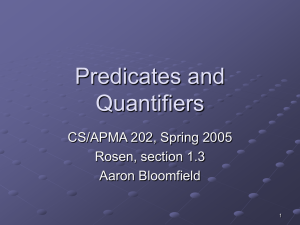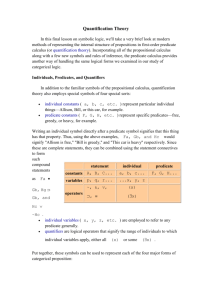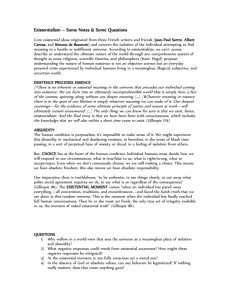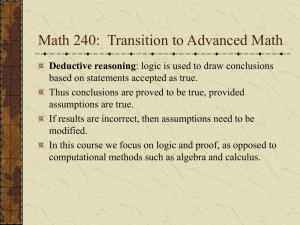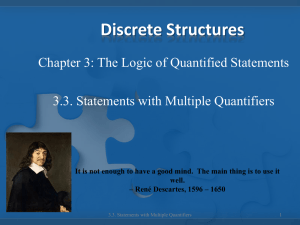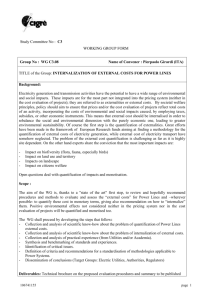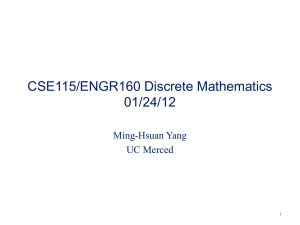Predicates and Quantifiers Terminology review Propositional functions
advertisement
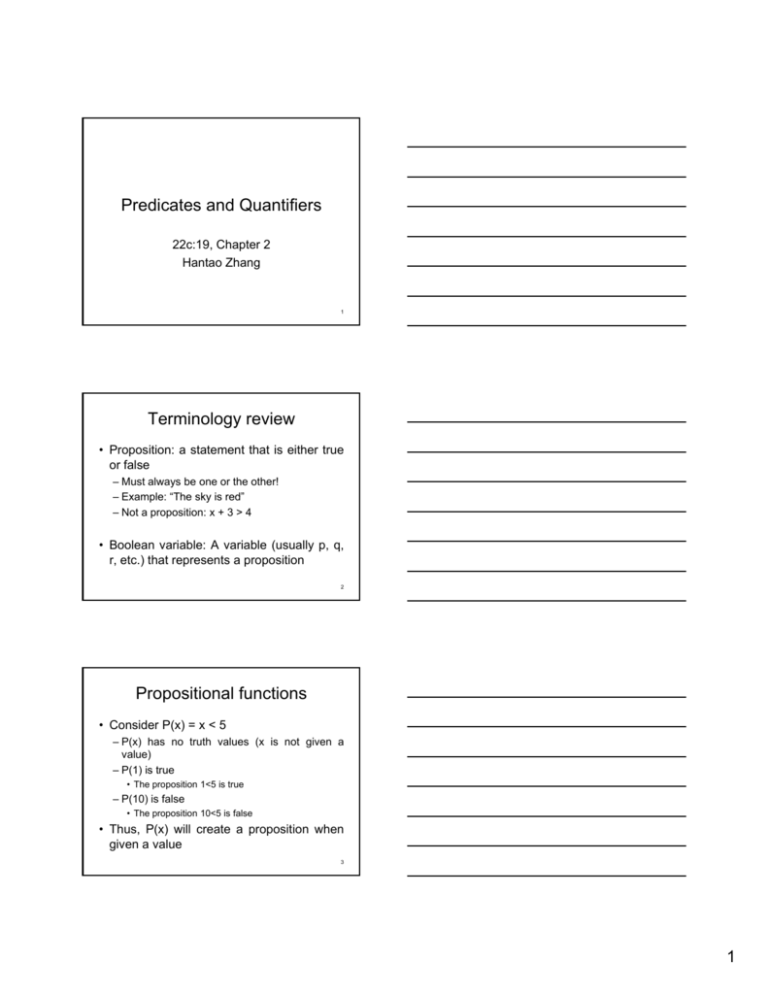
Predicates and Quantifiers 22c:19, Chapter 2 Hantao Zhang 1 Terminology review • Proposition: a statement that is either true or false – Must always be one or the other! – Example: “The The sky is red red” – Not a proposition: x + 3 > 4 • Boolean variable: A variable (usually p, q, r, etc.) that represents a proposition 2 Propositional functions • Consider P(x) = x < 5 – P(x) has no truth values (x is not given a value) – P(1) is true • The proposition 1<5 is true – P(10) is false • The proposition 10<5 is false • Thus, P(x) will create a proposition when given a value 3 1 Propositional functions • Let P(x) = “x is a multiple of 5” – For what values of x is P(x) true? • Let L t P(x) P( ) = x+1 +1 > x – For what values of x is P(x) true? • Let P(x) = x + 3 – For what values of x is P(x) true? 4 Anatomy of a propositional function P(x) = x + 5 > x variable i bl predicate di t 5 Propositional functions • Functions with multiple variables: – P(x,y) = x + y == 0 • P(1,2) P(1 2) is false, false P(1,-1) P(1 1) is true – P(x,y,z) = x + y == z • P(3,4,5) is false, P(1,2,3) is true – P(x1,x2,x3 … xn) = … 6 2 So, why do we care about quantifiers? • Many things (in this course and beyond) are specified using quantifiers – In some cases, it’s a more accurate way to describe things than Boolean propositions 7 Quantifiers • A quantifier is “an operator that limits the variables of a proposition” • Two T t types: – Universal – Existential 8 Universal quantifiers • Represented by an upside-down A: ∀ – It means “for all” – Let P(x) = x+1 > x • We can state the following: – ∀x P(x) – English translation: “for all values of x, P(x) is true” – English translation: “for all values of x, x+1>x is true” 9 3 Universal quantifiers • But is that always true? – ∀x P(x) • Let x = the character ‘a’ – Is ‘a’+1 a +1 > ‘a’? a? • Let x = the state of Virginia – Is Virginia+1 > Virginia? • You need to specify your universe! – What values x can represent – Called the “domain” or “universe of discourse” by the textbook 10 Universal quantifiers • Let the universe be the real numbers. – Then, ∀x P(x) is true • Let P(x) = x/2 < x – Not true for the negative numbers! – Thus, ∀x P(x) is false • When the domain is all the real numbers • In order to prove that a universal quantification is true, it must be shown for ALL cases • In order to prove that a universal quantification is false, it must be shown to be false for only ONE case 11 Universal quantification • Given some propositional function P(x) • And values in the universe x1 .. xn • The universal implies: quantification ∀x P(x) P(x1) ∧ P(x2) ∧ … ∧ P(xn) 12 4 Universal quantification • Think of ∀ as a for loop: • ∀x P(x), where 1 ≤ x ≤ 10 • … can be translated as … for ( x = 1; x <= 10; x++ ) is P(x) true? • If P(x) is true for all parts of the for loop, then ∀x P(x) – Consequently, if P(x) is false for any one value of the for loop, then ∀x P(x) is false 13 Existential quantification • Represented by an bacwards E: ∃ – It means “there exists” – Let P(x) = x+1 > x • We can state the following: – ∃x P(x) – English translation: “there exists (a value of) x such that P(x) is true” – English translation: “for at least one value of x, x+1>x is true” 14 Existential quantification • Note that you still have to specify your universe – If the universe we are talking about is all the states in the US, US then ∃x P(x) is not true • Let P(x) = x+1 < x – There is no numerical value x for which x+1<x – Thus, ∃x P(x) is false 15 5 Existential quantification • Let P(x) = x+1 > x – There is a numerical value for which x+1>x • In fact, it’s true for all of the values of x! – Thus, ∃x P(x) is true • In order to show an existential quantification is true, you only have to find ONE value • In order to show an existential quantification is false, you have to show it’s false for ALL values 16 Existential quantification • Given some propositional function P(x) • And values in the universe x1 .. xn • The existential implies: quantification ∃x P(x) P(x1) ∨ P(x2) ∨ … ∨ P(xn) 17 A note on quantifiers • Recall that P(x) is a propositional function – Let P(x) be “x == 0” • Recall that a proposition is a statement that is either true or false – P(x) P( ) is i nott a proposition iti • There are two ways to make a propositional function into a proposition: – Supply it with a value • For example, P(5) is false, P(0) is true – Provide a quantifiaction • For example, ∀x P(x) is false and ∃x P(x) is true – Let the universe of discourse be the real numbers 18 6 Binding variables • Let P(x,y) be x > y • Consider: ∀x P(x,y) – This is not a proposition! – What Wh t is i y? ? • If it’s 5, then ∀x P(x,y) is false • If it’s x-1, then ∀x P(x,y) is true • Note that y is not “bound” by a quantifier 19 Binding variables • (∃x P(x)) ∨ Q(x) – The x in Q(x) is not bound; thus not a proposition • (∃x P(x)) ∨ (∀x Q(x)) – Both x values are bound;; thus it is a p proposition p • (∃x P(x) ∧ Q(x)) ∨ (∀y R(y)) – All variables are bound; thus it is a proposition • (∃x P(x) ∧ Q(y)) ∨ (∀y R(y)) – The y in Q(y) is not bound; this not a proposition 20 Negating quantifications • Consider the statement: – All students in this class have red hair • What is required to show the statement is false? – There exists a student in this class that does NOT have red hair • To negate a universal quantification: – You negate the propositional function – AND you change to an existential quantification – ¬∀x P(x) = ∃x ¬P(x) 21 7 Negating quantifications • Consider the statement: – There is a student in this class with red hair • What is required to show the statement is false? – All students in this class do not have red hair • Thus, to negate an existential quantification: – Tou negate the propositional function – AND you change to a universal quantification – ¬∃x P(x) = ∀x ¬P(x) 22 Translating from English • Consider “For every student in this class, that student has studied calculus” • Rephrased: “For every student x in this class x has studied calculus class, calculus” – Let C(x) be “x has studied calculus” – Let S(x) be “x is a student” • ∀x C(x) – True if the universe of discourse is all students in this class 23 Translating from English • What about if the unvierse of discourse is all students (or all people?) – ∀x (S(x)∧C(x)) • This is wrong! Why? – ∀x (S(x)→C(x)) • Another option: – Let Q(x,y) be “x has stuided y” – ∀x (S(x)→Q(x, calculus)) 24 8 Translating from English • Consider: – “Some students have visited Mexico” – “Every student in this class has visited Canada or Mexico Mexico” • Let: – S(x) be “x is a student in this class” – M(x) be “x has visited Mexico” – C(x) be “x has visited Canada” 25 Translating from English • Consider: “Some students have visited Mexico” – Rephrasing: “There exists a student who has visited Mexico” • ∃x M(x) – True if the universe of discourse is all students • What about if the universe of discourse is all people? – ∃x (S(x) → M(x)) • This is wrong! Why? – ∃x (S(x) ∧ M(x)) 26 Translating from English • Consider: “Every student in this class has visited Canada or Mexico” • ∀x (M(x)∨C(x) – When Wh the th universe i off discourse di i allll students is t d t • ∀x (S(x)→(M(x)∨C(x)) – When the universe of discourse is all people • Why isn’t ∀x (S(x)∧(M(x)∨C(x))) correct? 27 9 Translating from English • Note that it would be easier to define V(x, y) as “x has visited y” – ∀x (S(x) ∧ V(x,Mexico)) – ∀x (S(x)→(V(x,Mexico) (S(x)→(V(x Mexico) ∨ V(x,Canada)) V(x Canada)) 28 Translating from English • Translate the statements: – – – – “All hummingbirds are richly colored” “No large birds live on honey” “Birds that do not live on honey are dull in color” “Hummingbirds Hummingbirds are small small” • Assign our propositional functions – – – – Let P(x) be “x is a hummingbird” Let Q(x) be “x is large” Let R(x) be “x lives on honey” Let S(x) be “x is richly colored” • Let our universe of discourse be all birds 29 Translating from English • Our propositional functions – – – – Let P(x) be “x is a hummingbird” Let Q(x) be “x is large” Let R(x) be “x lives on honey” Let S(x) be “x is richly colored” • Translate the statements: – “All hummingbirds are richly colored” • ∀x (P(x)→S(x)) – “No large birds live on honey” • ¬∃x (Q(x) ∧ R(x)) • Alternatively: ∀x (¬Q(x) ∨ ¬R(x)) – “Birds that do not live on honey are dull in color” • ∀x (¬R(x) → ¬S(x)) – “Hummingbirds are small” • ∀x (P(x) → ¬Q(x)) 30 10 Prolog • A programming language using logic! • Entering facts: instructor (bloomfield, cs202) enrolled (alice, cs202) enrolled (bob, cs202) enrolled (claire, cs202) • Entering predicates: teaches (P,S) :- instructor (P,C), enrolled (S,C) • Extracting data ?enrolled (alice, cs202) • Result: yes 31 Prolog • Extracting data ?enrolled (X, cs202) • Result: alice b b bob claire • Extracting data ?teaches (X, alice) • Result: bloomfield 32 Multiple quantifiers • You can have multiple quantifiers on a statement • ∀x∃y P(x, y) – “For For all x, x there exists a y such that P(x,y) P(x y)” – Example: ∀x∃y (x+y == 0) • ∃x∀y P(x,y) – There exists an x such that for all y P(x,y) is true” – Example: ∃x∀y (x*y == 0) 33 11 Order of quantifiers • ∃x∀y and ∀x∃y are not equivalent! • ∃x∀y P(x,y) – P(x,y) = (x+y == 0) is false • ∀x∃y P(x,y) – P(x,y) = (x+y == 0) is true 34 Negating multiple quantifiers • Recall negation rules for single quantifiers: – ¬∀x P(x) = ∃x ¬P(x) – ¬∃x P(x) = ∀x ¬P(x) – Essentially, you change the quantifier(s), and negate what it’s quantifying • Examples: – ¬(∀x∃y P(x,y)) = ∃x ¬∃y P(x,y) = ∃x∀y ¬P(x,y) – ¬(∀x∃y∀z P(x,y,z)) = ∃x¬∃y∀z P(x,y,z) = ∃x∀y¬∀z P(x,y,z) = ∃x∀y∃z ¬P(x,y,z) 35 Negating multiple quantifiers • Consider ¬(∀x∃y P(x,y)) = ∃x∀y ¬P(x,y) – The left side is saying “for all x, there exists a y such that P is true” – To disprove it (negate it), you need to show that “th “there exists i t an x such h that th t for f allll y, P is i false” f l ” • Consider ¬(∃x∀y P(x,y)) = ∀x∃y ¬P(x,y) – The left side is saying “there exists an x such that for all y, P is true” – To disprove it (negate it), you need to show that “for all x, there exists a y such that P is false” 36 12 Translating between English and quantifiers • The product of two negative integers is positive – ∀x∀y ((x<0) ∧ (y<0) → (xy > 0)) – Why conditional instead of and? • The average of two positive integers is positive – ∀x∀y ((x ((x>0) 0) ∧ (y (y>0) 0) → ((x ((x+y)/2 y)/2 > 0)) • The difference of two negative integers is not necessarily negative – ∃x∃y ((x<0) ∧ (y<0) ∧ (x-y≥0)) – Why and instead of conditional? • The absolute value of the sum of two integers does not exceed the sum of the absolute values of these integers – ∀x∀y (|x+y| ≤ |x| + |y|) 37 Translating between English and quantifiers • ∃x∀y (x+y = y) – There exists an additive identity for all real numbers • ∀x∀y (((x≥0) ∧ (y<0)) → (x-y > 0)) – A non-negative g number minus a negative g number is greater than zero • ∃x∃y (((x≤0) ∧ (y≤0)) ∧ (x-y > 0)) – The difference between two non-positive numbers is not necessarily non-positive (i.e. can be positive) • ∀x∀y (((x≠0) ∧ (y≠0)) ↔ (xy ≠ 0)) – The product of two non-zero numbers is non-zero if and only if both factors are non-zero 38 Negation examples • Rewrite these statements so that the negations only appear within the predicates a) ¬∃y∃x P(x,y) ∀y¬∃x P(x,y) ∀y∀x y ¬P(x,y) ( ,y) b) ¬∀x∃y P(x,y) ∃x¬∃y P(x,y) ∃x∀y ¬P(x,y) c) ¬∃y (Q(y) ∧ ∀x ¬R(x,y)) ∀y ¬(Q(y) ∧ ∀x ¬R(x,y)) ∀y (¬Q(y) ∨ ¬(∀x ¬R(x,y))) ∀y (¬Q(y) ∨ ∃x R(x,y)) 39 13 Negation examples • a) Express the negations of each of these statements so that all negation symbols immediately precede predicates. ∀x∃y∀z T(x,y,z) b) ∀x∃y P(x,y) ∨ ∀x∃y Q(x,y) ¬(∀x∃y∀z T(x,y,z)) ¬∀x∃y∀z T(x,y,z) ∃x¬∃y∀z T(x,y,z) ∃x∀y¬∀z T(x,y,z) ∃x∀y∃z ¬T(x,y,z) ¬(∀x∃y P(x,y) ∨ ∀x∃y Q(x,y)) ¬∀x∃y P(x,y) ∧ ¬∀x∃y Q(x,y) ∃x¬∃y P(x,y) ∧ ∃x¬∃y Q(x,y) ∃x∀y ¬P(x,y) ∧ ∃x∀y ¬Q(x,y) 40 Rules of inference for the universal quantifier • Assume that we know that ∀x P(x) is true – Then we can conclude that P(c) is true • Here c stands for some specific constant – This is called “universal universal instantiation instantiation” • Assume that we know that P(c) is true for any value of c – Then we can conclude that ∀x P(x) is true – This is called “universal generalization” 41 Rules of inference for the existential quantifier • Assume that we know that ∃x P(x) is true – Then we can conclude that P(c) is true for some value of c – This is called “existential existential instantiation instantiation” • Assume that we know that P(c) is true for some value of c – Then we can conclude that ∃x P(x) is true – This is called “existential generalization” 42 14 Example of proof • Given the hypotheses: – “Linda, a student in this class, owns a red convertible.” – “Everybody Everybody who owns a red convertible has gotten at least one speeding ticket” • Can you conclude: “Somebody in this class has gotten a speeding ticket”? C(Linda) ( ) R(Linda) ∀x (R(x)→T(x)) ∃x (C(x)∧T(x)) 43 Example of proof 1. 2. 3. 4. 5. 6. 7. ∀x (R(x)→T(x)) R(Linda) → T(Linda) R(Linda) T(Linda) C(Linda) C(Linda) ∧ T(Linda) ∃x (C(x)∧T(x)) 3rd hypothesis Universal instantiation using step 1 2nd hypothesis Modes ponens using steps 2 & 3 1st hypothesis Conjunction using steps 4 & 5 Existential generalization using step 6 Thus, we have shown that “Somebody in this class has gotten a speeding ticket” 44 Example of proof • Given the hypotheses: – “There is someone in this class who has been to France” – “Everyone who goes to France visits the Louvre” • Can you conclude: “Someone in this class has visited the Louvre”? ∃x ((C(x)∧F(x)) ( ) ( )) ∀x (F(x)→L(x)) ∃x (C(x)∧L(x)) 45 15 Example of proof 1. 2. 3. 4. 5. 6. 7. 8. 9. ∃x (C(x)∧F(x)) C(y) ∧ F(y) F(y) C(y) ∀x (F(x)→L(x)) F(y) → L(y) L(y) C(y) ∧ L(y) ∃x (C(x)∧L(x)) 1st hypothesis Existential instantiation using step 1 Simplification using step 2 Simplification using step 2 2nd hypothesis Universal instantiation using step 5 Modus ponens using steps 3 & 6 Conjunction using steps 4 & 7 Existential generalization using step 8 Thus, we have shown that “Someone in this class has visited the Louvre” 46 16
